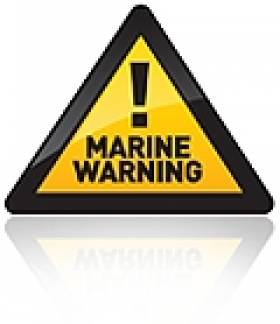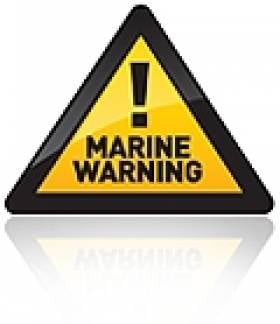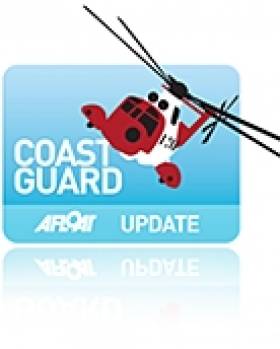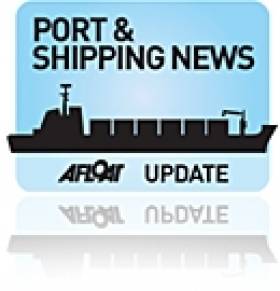Displaying items by tag: Coast
Coast Guard Advises Caution in Severe Weather
The Irish Coast Guard has advised members of the public to take care in the current severe weather conditions, particularly around the coast and in exposed areas.
Sea Activities
Avoid sea or water-based activities today if possible.
Cliff Walking
There is safety in numbers. Always let someone know when and where you are going, and when you are expected to return. Stay well away from cliff edges, both top and bottom. Don't attempt to rescue people or pets if they fell over a cliff edge. If assistance is needed dial 999 or 112 and ask for the Coast Guard.
Lough Derg Lifeboat Rescues Three after Yacht Capsizes
At 17.04hrs Saturday September 10, Lough Derg RNLI Lifeboat was requested to launch by Valentia Coast Guard following a report of two persons in the water off Hare Island, on Lough Derg. At 17.15hrs, the lifeboat was launched with Helm Colin knight, Johnny Hoare and Ger Egan on board, and was on scene 17.20hrs. The wind was southwest, force 6, with a 5ft to 6ft swell, visibility was good.
When the RNL lifeboat arrived on scene, a passing yacht was recovering two persons onto their yacht, but had lost a visual on the third person. The lifeboat immediately carried out a search pattern, located the third casualty some four or five hundred metres away, and recovered them to the lifeboat.
Lifeboat Helm Colin Knight said "these three people were very very lucky; the passing yacht only became aware of their plight when, on tacking, one of sailors heard calls for help on the wind and raised the alarm". He continued, "the persons were in the water for at least thirty minutes, in fairly hostile conditions, when the only boat in the vicinity heard their calls for help, someone was looking after them today".
Tasked by Valentia Coast Guard, the Irish Coast Guard Search & Rescue Helicopter team, Rescue 115, took off from their base at Shannon at 17.34hrs. Killaloe Coast Guard had also launched to assist. After establishing that the RNLI lifeboat could be at their station within 5 minutes, Rescue 115 requested the crew to take the casualties to Dromineer from where they5 would transfer the casualties to hospital.
The RNLI lifeboat returned to the yacht, and took a second casualty on board. Killaloe Coast Guard boat took the third person. All were then rushed back to Drominneer where they were met by the helicopter and transferred to Limerick Regional hospital for further treatment.
The lifeboat then returned to 'The Hare' to see if the sunken vessel was a navigational hazard, but there was no sign of wreckage or of the yacht. The lifeboat returned to station and was ready for service again at 18.50hrs.
While it might be an exaggeration to say that all of the 21 crew members of Rambler 100 owe their lives to the Irish Search and Rescue service, there are certainly five people whose future prospects were greatly improved by the operation off the Fastnet Rock on August 15th. A lot of media focus has been on Coxswain Kieran Cotter and the crew of Baltimore Lifeboat as well as lifeboat mechanic Jerry Smith, whose dive boat, on charter to the media team of one of the competitors, was on hand to search and recover the five drifting crew. There is no question that this focus is appropriate. RNLI crews all over the UK and Ireland deserve the attention, not only because of their extraordinary voluntary dedication to the cause, but also because such publicity helps swell the coffers of the charity. The service could not operate without the generosity of the donors and incidents such as these help fill the blue boat-shaped boxes held by even more RNLI volunteers.

Saved: Ireland's Rescue Services Answered the Call of the capsized Supermaxi Rambler 100 off the Fastnet Rock. Photo: Team Phaedo
The dramatic stories and pictures dominating the media show the front line of a quite wonderful resource that is Search and Rescue in Ireland today. Baltimore Lifeboat was at the coal face of an intricate network of operations, triggered by the crew's EPIRBs. Irish Coast Guard radio officers in Valentia responded almost immediately tasking the rescue resources, working the phones and computers to confirm that this was not an accidentally triggered EPIRB, contacting RORC HQ, determining search patterns and relaying the information to the scene. It was the backroom contacts between RORC and the Coast Guard in endeavouring to contact Rambler 100 using satellite phones that confirmed the possibility of a catastrophic incident involving the Supermaxi. The subsequent tasking of the Shannon and Waterford based Sikorsky helicopters led to the medevac of crew member Wendy Touton and timely treatment of her hypothermic condition, initially by the on-board paramedics and later at Tralee General hospital. And Coast Guard involvement didn't end with the successful rescue – the shoreside operation to provide food and shelter in Baltimore was coordinated by Coast Guard personnel and the salvage operation of the hull of Rambler 100 was overseen by the Irish Coast Guard.

Rambler crew are recovered from the water after a SAR operation by the Irish Coastguard Photo: Team Phaedo. More photos here.
That Ireland has probably one of the best Search and Rescue services in the world goes back to the campaign initiated in 1988 by Joan McGinley, following the death, within sight of land of Donegal fisherman John Oglesby, whose leg was severed in a trawl winch. Eamon Doherty, the late former Garda Commissioner chaired the review group established in response to the campaign and his report led to the establishment of the Irish Marine Emergency Service, subsequently the Irish Coast Guard. Under the guidance of Director Capt Liam Kirwan, the new service moved quickly to become not only the central co-ordinating body for Search and Rescue, but developed its own resources, notably the helicopters, previously tasked in from Irish Air Corps and UK SAR.
Another element that will feature in the Rambler 100 incident is the Marine Casualty Investigation Board (MCIB), set up from recommendations arising from a review of the handling of investigations into marine casualties.
It might be thought that the incident is now closed, but there are many unanswered questions and the investigation will be looking at these and making recommendations that should improve safety in this sector. These questions will include EPIRB performance, liferaft deployment and grab bag usage, but perhaps the key issue yet to be determined is why the response from fellow competitors didn't appear to happen. Even if Channel 16 wasn't being actively monitored, and if not why not, shouldn't the Mayday set off by the Coast Guard have set off the DSC alerts on the radios of Rambler 100's fellow competitors? Had the incident occurred several hours later or earlier when Rambler 100 could have been up to 100 miles from the nearest land, when conditions worsened, we could be looking at much more serious consequences.
It is heartening to think that, in this small country of ours in troubled times, not only do we have a shining star in our search, rescue, recovery and restore system, involving professionals and volunteers cooperating for the greater good, we also have a system that determines the nature of incidents so that we can all learn from the experience.
And let us not forget those people and services, such as the Gardai, Navy, Army and the community of Baltimore who are outside the media spotlight who contributed to this happy ending.
Afloat's Latest Coastguard News
Afloat's Latest RNLI Lifeboat News
Afloat's Latest MCIB News
Coast Guard in Fourth Medical Evacuation This Week
The incident was co-ordinated by the Marine Rescue Co-ordination Centre of the Irish Coast Guard at Valentia which tasked the Shannon-based helicopter this morning to travel with an A&E Registrar from Cork University Hospital to treat the injured crew member en-route. Crews on these helicopter are also trained to paramedic standard. The helicopter arrived on scene at 14:37pm this afternoon and crew and medical personnel administered treatment to the casualty. The helicopter travelled onward to Tralee Regional Hospital where it arrived at approximately 16:30pm this afternoon. The Air Corps Casa aircraft provided top-cover for the helicopter during this incident.
Coast Guard Issues Advice for the August Bank Holiday
The following are general safety tips and advice to help enjoy the water and coastal activities in your area this weekend.
Swimming
Only swim at beaches and waterways that have Lifeguards on duty and pay attention to the safety flags. Ask the Lifeguard for advice about safety and water conditions and adhere to their instructions. Avoid using inflatable toys, such as lilos and rubber rings, on the water.
Cliff Walking
There is safety in numbers never be alone if possible. Let somebody know when & where you are going and what time you will be back . Stay well away from the cliff edge, both top and bottom. Don't attempt to rescue people or pets if they fall over the edge. If assistance is required dial 112 and ask for Coast Guard.
Water Sports and Coastal Activities
Before going to sea check local weather conditions and tides in the area. Wear correctly maintained and fitting lifejackets that are suitable for the activity. Lifejackets are of no use unless they are worn. Ensure your craft is fit for purpose.
Do not overload the craft. If you are in difficulty or see someone in difficulty and requiring assistance dial 999/112 and ask for Coast Guard.
Swim, walk, boat, surf, sail, canoe and enjoy our cliffs, beaches, seas, and waterways this weekend - but do it safely.
Irish Sea Sailor Makes Call for Help
It transpired that the caller was a sailor onboard his catamaran with his wife south of the Isle of Man who had taken some water on the vessel and believed that he was sinking.
Liverpool Coastguard working with the coastguards at the marine operations centre, Douglas on the Isle of Man requested the launch of the Port St Mary and Port Erin RNLI lifeboats to locate the vessel and render assistance.
The lifeboats located the vessel and pumped water from one of the hulls and towed it into port.
Paul Parkes, Watch Manager, Liverpool Coastguard said:
We recommend that you have adequate training in the use of VHF radio equipment, to ensure that when you have a situation that causes you concern, you make the appropriate call to secure the best possible response.
It is recommended that you fit VHF DSC radio equipment to your vessel which would enable the Coastguard to receive an accurate position of your vessel.
Agreement Strengthens Irish and French Search and Rescue
The Irish Coast Guard has signed up to an important Search and Rescue cooperation agreement with the French Coast Guard.
Director of the Irish Coast Guard Chris Reynolds and Vice Admiral Anne-Francois de Saint-Salvy, Prefecture for the Atlantic Region and the Director of the French Coast Guard this morning signed an important agreement in Dublin on co-operation regarding Search and Rescue services.
The agreement further strengthens Irish and French co-operation for search and rescues services in the respective search and rescue regions.
The International Convention on Maritime Search and Rescue provides for and encourages neighbouring countries to co-operate and assist one another in life-saving matters of search and rescue.
This technical agreement allows for the mutual cooperation and interoperability of aviation assets in the event of a major incident off Irelands south coast.
Both Coast Guards can provide either long range medium load helicopters or fixed wing aircraft that can intervene directly in support of the responsible coordinating search and rescue authority. While these events are rare it is necessary that such eventualities be considered and practised so as to be prepared for any eventuality.
Both Coast Guards absorb their own costs and so no additional burden is placed on the State. Both Coast Guards also recognise that similar support may be possible in the event of ship casualties within their respective Exclusive Economic Zones (EEZ) such as obtaining top cover for a long range helicopter mission to put a salvage team aboard a stricken vessel in our region.
In all these scenarios the Irish Air Corps will remain the Irish Coast Guards first call for fixed wing top cover from their CASA aircraft.
Speaking today, Director of the Irish Coast Guard, Chris Reynolds said: "This agreement is a very welcome development and will be mutually beneficial to the search and rescue capability provided by both our countries."
Mussel Dredgers Make a Fleeting Trawl of Dalkey Sound
Two mussel dredger-trawlers made a rare transit of Dalkey Sound, last Friday, writes Jehan Ashmore.
The sound which is located to the south of Dublin Bay is not used by commercial traffic but is frequented by pleasure-craft, local fishing boats from Dun Laoghaire. In addition to occasional traffic by the Irish Naval Service, Marine Institute research vessel RV Celtic Voyager, the GSI's RV Keary and foreign tall-ships.

Dublin Bay. Photo Jehan Ashmore/ShipSNAPS
The vessels were making a southerly direction as they headed across Dublin Bay towards Dalkey Island. Mytilus lowered a mussel cage bucket into the sound which was dragged on two separate occasions over a short distance running parallel between the island and the coast.
The operation was all too brief as the Mytilus then proceeded into Killiney Bay followed closely astern by Branding. Upon entering the neighbouring bay, both vessels conducted dredging activity before continuing south beyond Bray Head.
Mussel grounds are located throughout certain hotspots in the Irish Sea and earlier this month, it is reported that there was a notable increase in mussel dredgers in Bangor, Northern Ireland. The dredgers were the Mytilus and Branding which berthed at the Co. Down harbour after a lengthy period of relative inactivity.
Mytilus was built in The Netherlands by Scheepwerf Van Os Yerseke B.V. and appeared in an episode of the successful BBC TV series 'Coast'. At the time of the broadcast she was registered at Beaumaris, Anglesey and was seen working in the northern approaches of the Menai Straits. The fishery grounds are ideally suited for the growing processes required in farmed mussel production.
Branding was also built by a Dutch shipyard, Kooieman in 1988 and her design is typical of the mussel dredgers based in Wexford. The market for mussels is mainly from the northern European countries of Belgium, France and the Netherlands.
- Dublin Bay
- Coast
- Marine Institute
- Northern Ireland
- naval service
- Dublin Bay News
- Anglesey
- Ports and Shipping News
- Island News
- RV Celtic Voyager
- TallShips
- RV Keary
- Geological Survey of Ireland
- GSI
- Mussel dredgers
- Mussel trawlers
- Mytilus
- Branding
- Dalkey Sound
- Fishery
- Menai Strait
- Beaumaris
- Banger
- Fish news
- BBC
- BBC TV series 'Coast'
- Belfastregistered
- Wexfordregistered
- Dutchbuilt
- Mussel markets
- Killiney Bay
- Bray Head
Inspection of Refloated Ship in Galway Bay Under Way
Marine surveyors are currently inspecting the German cargo ship which was refloated yesterday in Galway Bay after running aground early on Thursday.
The Irish Coast Guard confirmed to The Irish Times that no pollution had occurred in the grounding of the Pantanal on the south Connemara coast.
The 120m vessel was refloated at high tide yesterday morning with help from the Celtic Isle tug from Foynes in Co Limerick.
Ship managers Harren & Partner said the hull would undergo a diver inspection before the vessel sails for dry dock.
Yesterday Minister for the Marine Simon Coveney welcomed the "successful operation in very challenging conditions" and confirmed a thorough investigation of the incident by the Marine Casualty Investigation Board.
The ship had been sailing from the Mediterranean to Rossaveal to collect two monohull ferries, sold to Mauritius, that had been built to serve the Aran Islands route.
The Irish Times has more on the story HERE.
Search Resumes for Missing Fishermen Off Skerries
The lifeboat and Coastguard search for two fishermen missing off the north Co Dublin coast has resumed this morning.
The Irish Times reports that the two men, believed to be in their 20s and 40s, were on a small open fishing boat that departed Skerries harbour around 11am yesterday (Friday 1 April). The alarm was raised at 6.30pm when they failed to return to port.
A Dublin Coast Guard spokesperson confirmed that items and debris believed to be from the missing boat were discovered during the initial search yesterday evening.
The search, involving three coastguard units, three lifeboats and a number of local vessels, was scheduled to resume at 7am this morning.
RTÉ News has more on the story - including video - HERE.






































































